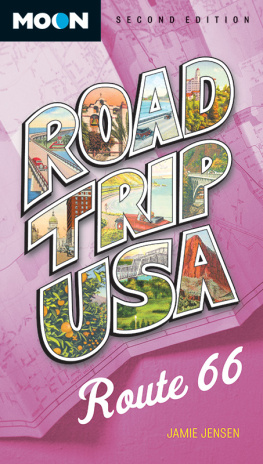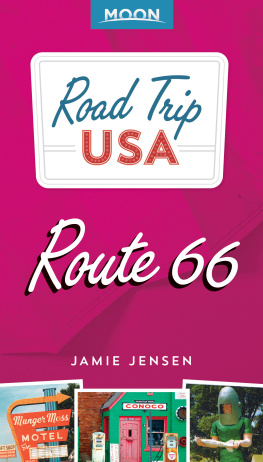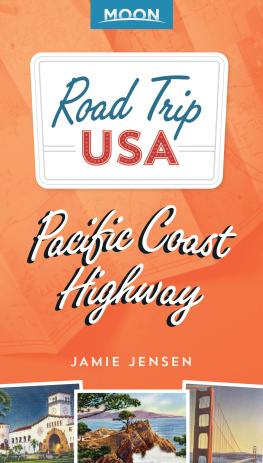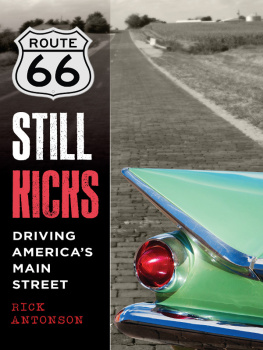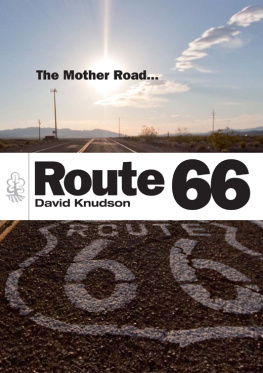
Attractions
Between Chicago, Illinois, and Los Angeles, California
T he romance of Route 66 continues to captivate people around the world. Running between Chicago and Los Angeles, over two thousand miles all the way in the words of the popular R&B anthem, this legendary old road passes through the heart of the United States on a diagonal trip that takes in some of the countrys most archetypal roadside scenes. If youre looking for great displays of neon signs, rusty middle-of-nowhere truck stops, or kitschy Americana, do as the song says and get your kicks on Route 66.
But perhaps the most compelling reason to follow Route 66 is to experience the roads ingrained time line of contemporary America. Before it was called Route 66, and long before it was even paved in 1926, this corridor was traversed by the National Old Trails Highway, one of the countrys first transcontinental highways. For three decades before and after World War II, Route 66 earned the title Main Street of America because it wound through small towns across the Midwest and Southwest, lined by hundreds of cafs, motels, gas stations, and tourist attractions. During the Great Depression, hundreds of thousands of farm families, displaced from the Dust Bowl, made their way west along Route 66 to California, following what John Steinbeck called The Mother Road in his vivid portrait, The Grapes of Wrath. After World War II, many thousands more expressed their upward mobility by leaving the industrial East, bound for good jobs in the suburban idyll of Southern Californiaagain following Route 66, which came to embody the demographic shift from the Rust Belt to the Sun Belt.
Beginning in the late 1950s and continuing gradually over the next 25 years, old Route 66 was bypassed section by section as the high-speed Interstate highways were completed. Finally, after the last stretch of freeway was completed in 1984, Route 66 was officially decommissioned. The old route is now designated Historic Route 66.
Though it is no longer a main route across the country, Route 66 has retained its mystique in part due to the very same effective hype, hucksterism, and boosterism that animated it through its half-century heyday. It was a Route 66 sight, the marvelous Meramec Caverns, that gave the world the bumper sticker, and it was here on Route 66 that the great American driving vacation first flourished. Billboards and giant statues along the highway still hawk a baffling array of roadside attractions, tempting passing travelers to view giant blue whales, to see live rattlesnakes and other wild creatures on display in roadside menageries, or to stay at Tucumcari Tonite.
The same commercial know-how and shameless self-promotion has helped the towns along the old route stay alive. Diners and motels play up their Route 66 connections, and many bona fide Route 66 landmarks are kept in business by nostalgic travelers intent on experiencing a taste of this endlessly endangered American experience. That said, many quirky old motels and cafs hang on by a thread of hope, sit vacant, or survive in memory onlyall for want of an Interstate exit. In fact, of all the roads covered in this book, Route 66 has perhaps felt the greatest impact from the modern Interstate world; for many stretches youll be forced to leave the old two-lane and follow the super slabs that have been built right on top of the old road.
Route 66 passes through a marvelous cross-section of American scenes, from the cornfields of Illinois all the way to the golden sands and sunshine of Los Angeles, passing by such diverse environs as the Grand Canyon, the Native American communities of the desert Southwest, the small-town Midwest heartlands of Oklahoma and the Ozarks, as well as the gritty streets of St. Louis and Chicago. Whether you are motivated by an interest in history, feel a nostalgic yearning for the good old days Route 66 has come to represent, or simply want to experience firsthand the amazing diversity of people and landscapes that line its path, Route 66 offers an unforgettable journey into America, then and now.
Heading diagonally across the state between Chicago and St. Louis, what remains of Route 66 is a surprisingly rural cruise through endless fields of corn. Despite the urban conglomerations at both ends, for most of its nearly 300-mile trek here, Route 66 and its modern usurper, I-55, pass along flat prairies with nary a smokestack or skyscraper as far as the eye can see.
The heavy industrial and poverty-stricken hinterlands of Chicago and East St. Louis arent terribly rewarding for travelers in search of the Mother Road, but a couple of intriguing attractionsone a prehistoric city, the other a water tower shaped like a catsup bottleare worth searching out. The only real city along Route 66 is the Illinois state capital, Springfield, which has preserved its sections of Route 66 alongside a wealth of places connected to the namesake president here in the Land of Lincoln. Dozens of small towns across the state play up their Route 66 connections, and most boast at least one true old-road landmark.
At Plainfield, a little piece of highway history happened when the original version of Route 66 crossed the even older Lincoln Highway, Americas first transcontinental road.
Following the first (or last) leg of Route 66 across Chicago and its hinterlands is really not worth the effort for anyone except the most die-hard end-to-endereven Jack Rittenhouse, in his original 1946 A Guide Book to Highway 66, didnt bother to describe the route until it reached Plainfield, 35 miles southwest of the Loop. For a symbolic starting point, you can use the grand old Art Institute of Chicago in Grant Park along the lakeshore, since the last US-66 shield used to hang from a streetlight just south of the gallery. If Chicago is your end of the road, youll probably prefer to avoid the final few miles of surface streets and make your way to town as quickly as possible via I-55.
From Lake Michigan, the old road ran west via Adams Street (take Jackson Boulevard eastbound; both are one-way) before angling southwest along Ogden Avenuea long, diagonal exception to the citys main grid of streets. Cicero prides itself on having been a haven to Al Capone and other mobsters during the Prohibition era and now enjoys its Route 66 connections at Henrys Drive-In (6031 W. Ogden Ave.; 708/656-9344), where you can snack on excellent Polish hot dogs smothered with a pile of french fries. Neighboring Berwyn has lined old Route 66 with a series of glass-block markers but didnt do much to save its most remarkable work of art: The Spindle, a tower of ruined cars impaled on a 50-foot steel spike, which stood in the parking lot of a shopping mall until mid-2008, when it was removed in the middle of the night to make way for yet another Walgreens. (You may have seen The Spindle in the 1990s comedy Waynes World.)
To continue south and west, you have to follow I-55, which was built right on top of old Route 66. In Willowbrook, off Hwy-83 on the north side of I-55 about 20 miles from the Loop,
Next page
